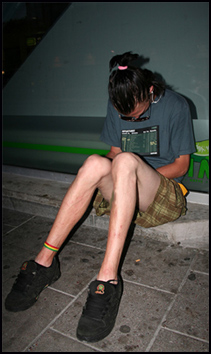
In Van Nuys, CA, a 67-year-old woman was purposely set on fire as she slept on a bus bench — one of those unfriendly pieces of public furniture specifically designed to be uncomfortable, with rigid dividers between each designated seat. But maybe, through the layers of clothing she habitually wears, Violet Phillips didn’t even feel the bumps. To be soaked with flammable liquid and then lit on fire causes pain of a different order of magnitude. Undoubtedly, Violet feels the serious burns.
Violet is what people call her at the local churches, where she is acquainted with many parishioners. But she likes to keep to herself. Journalist Mike Szymanski spoke with a representative of the intensive care unit of the University of Southern California Burn Unit and learned that:
… [S]he would only say ‘God bless you’ in reply to people’s questions.
This abominable attack happened two days after Christmas, too late to be referenced in stories about the release of the National Coalition for the Homeless (NCH) report on hate crimes of 2011, but just in time to be included in the 2012 total. The individual who has been arrested, on suspicion of attempted murder, is 24-year-old male. Let’s see how this fits in with the NCH report, which says:
… [N]early all of the attacks were carried out by teenagers and young men.
A lot of these young so-called men reportedly do these things just for fun. On behalf of The Huffington Post, Saki Knafo spoke with NCH executive director Neil Donovan, who feels that one of the big problems is the desensitization caused by electronic games that cast people experiencing homelessness in the role of targets. Also contributing to the stigmatization and degradation are video productions like “Bag Lady Fights” and “BumFights.” Donovan calls it a “campaign of dehumanization.”
But how many attacks, or anti-homeless hate crimes, are we talking about? Here’s the breakdown:
… [A]t least 32 homeless people in the United States died as a result of violent attacks in 2011, as compared with 24 the year before. The report also tallied 73 non-lethal attacks against the homeless, a drop from the previous year’s count of 89.
Despite a serious lack of funding, since 1999, the NCH has taken on the mission and challenge of filling the informational void. Their latest report is titled “Hate Crimes against the Homeless: The Brutality of Violence Unveiled” and the 94-page PDF file can be downloaded from the top of the NCH homepage. The FBI does not define the homeless as a protected group, and is not interested in keeping track of anti-homeless hate crimes. But it does tally up other hate crimes in America, and here is the alarming thing, as Knafo puts it:
… [T]he number of lethal anti-homeless hate crimes counted by the group exceeds the government’s tally of deadly hate crimes in all other categories.
In other words, for several years now, the number of homeless people murdered because of who they are has exceeded the number of victims of fatal hate crimes from all other (racial, religious, etc.) motivations, added together.
It’s a terrifyingly stringent economy where they can’t even place a foot on the first rung of the ladder to success, or even modest prosperity. In the late ’70s, the “deinstitutionalization” trend started, and was supported by many factions, for reasons that seemed good at the time. Unfortunately, psychiatric institutions were not replaced by other support systems. The combination of these national changes with other factors resulted in the current crisis where people are getting killed simply because they don’t have a place to live. Another aspect of this situation is, the elderly and confused are not the whole population of people experiencing homelessness. An enormous number of young people are out there trying to make it on their own.
Susan Saulny’s “After Recession, More Young Adults Are Living on Street,” is a companion piece to her earlier video reportage “Young and Homeless: The Recession’s Impact on Young Americans.” She talks about Los Angeles, where in 2011, there were about 3,600 unfamilied kids on the streets. The city’s shelter could sleep less than one-fifth of them. Boston is bad, all cities are bad, but the suburbs or country are nearly impossible.
The young do have one advantage. They are not so likely to be victims of the anti-homeless hate crimes per se, being better able to blend into the population. Kids like to look scruffy, and sometimes it’s hard to determine who is rich and who is destitute, on the evidence of clothes and hygiene. Plus, the young are more easily able to run away. But in shelters, it’s a different story. Saulny says the young:
[…] tend to shy away from ordinary shelters out of fear of being victimized by an older, chronically homeless population.
What is the answer? One of answers is to make sure there are jobs, both for homeless youth, so they can afford to live someplace, and for the aimless young men who victimize the homeless for kicks. Richard R. Troxell, as we know, is co-founder of House the Homeless in Austin, TX, and author of Looking Up at the Bottom Line. He recently wrote:
I sit on the Board of the National Coalition for the Homeless that produced this report. I also sit on the Civil Rights Committee and we actually generated this report. The young need to be engaged in living-wage jobs. So we need to promote our stimulus recommendations to President Obama, in order to create jobs, and then those jobs need to pay living wages.
Please learn more about the Universal Living Wage.
Reactions?
Source: “Homeless Burn Victim, Violet Phillips, Remains in Critical Condition,” Sherman Oaks Patch, 12/28/12
Source: “Anti-Homeless Hate Crimes Detailed In New Report,” The Huffington Post, 12/21/12
Source: “After Recession, More Young Adults Are Living on Street,” The New York Times, 12/18/12
Image by danieljordahl.


